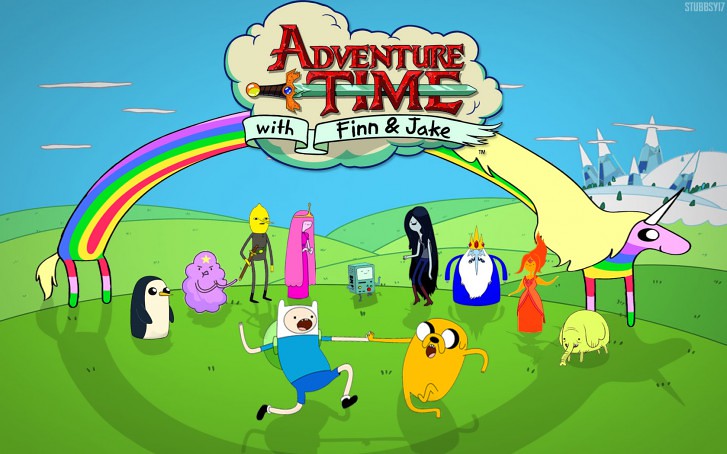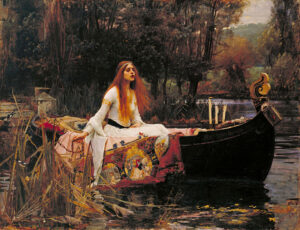When I say “King Arthur,” what do you picture? A very English-looking knight, confidently receiving a sword from the most reliable of kingmakers: strange women living in lakes. Or maybe he’s being followed by his trusty coconut-wielding squire as he debates the ability of load-bearing sparrows with a French knight (heavy on the k and gh). But what about the Celtic Arthur who fought the Saxons?
And what about when I say “The Lady of Shalott”? Do you picture Waterhouse’s 1888 painting above, or think of Tennyson’s 1833 poem. Or do you instead imagine Anne Shirley slowly walking as she recites the poem?
That’s all about as anachronistic as some 14th century wool customs bureaucrat taking to Twitter:
So what’s going on here? When thinking of something as medieval, why do we imagine stories and pictures composed after the Middle Ages?
I’m glad you asked.
There’s a growing object of study that looks at this very thing. It’s called medievalism, and it’s boundary lines are pretty fuzzy. We don’t know if we should call it its own discipline. Should it be a subset of or separated from medieval studies? Should it be housed in different literary periods? For example, I usually present myself as a Victorianist who focuses on Victorian medievalism.
And where do we put Tolkien and Lewis and all the rest of 20th century medievalisms?
Or what about Chesterton’s The Ballad of the White Horse wherein Roman antiquity is telescoped with Celtic and early medieval Britain?
Leslie Workman separates the study of medievalism and the study of the Middle Ages themselves, arguing that medievalism should be described as the “process of creating the Middle Ages,” meaning that it is “the study not of the Middle Ages themselves but of the scholars, artists, and writers who…constructed the idea of the Middle Ages that we inherited.” The Tolkien scholar, Tom Shippey, corroborates this view by proposing that medievalism is “the study of responses to the Middle Ages at all periods since a sense of the mediaeval began to develop.”
In an excellent recent study, Medivalism: A Critical History, David Matthews examines this burgeoning discipline/anti-discipline and concludes that the lines between medieval studies and medievalism studies aren’t so clear as definitions like “the process of creating the Middle Ages” suggest. For starters, every act of scholarship by a medievalist, as Matthews notes, is itself an artifact of medievalism.
For instance, a paper given at a conference on scribal errors in a particular medieval manuscript will be an example of medievalism since it is part of “the process of creating the Middle Ages.” Looking at the field this way would unite that paper with the panel on the medieval and monastic roots of the contemporary craft brewing movement or my own paper on Victorian authors.
It seems then that there are many different medievalisms. There’s a medievalism that explains the phenomenon of HBO’s Game of Thrones and Peter Jackson’s LOTR films. There’s another medievalism that explains the medieval revival undertaken by Romantic and Victorian writers.
But if there are so many medievalisms, then how can we get our heads around them?
Umberto Eco created an interesting taxonomy in “Dreaming of the Middle Ages” that could be a way to start thinking about this problem:
- “The Middle Ages as a pretext“
- Matthews explains this category as works where “the historical background of the Middle Ages is used as a setting, but there is no real interest in history.” Personally, I might put Dungeons and Dragons here or in number 3 below.
- “The Middle Ages as the site of an ironical visitation“
- If Don Quixote comes to mind, then you’re on the right track. As Eco puts it, “…Cervantes revisit[s] the Middle Ages in the same way that Sergio Leone and the other masters of the ‘spaghetti western’ revisit nineteenth-century America, as heroic fantasy…”
- “The Middle Ages as a barbaric age, a land of elementary and outlaw feelings”
- Ever notice how so many popular medieval films tend to be dark and grungy even though medieval manuscripts are filled with color?
- “The Middle Ages of Romanticism with their stormy castles and their ghosts.”
- Bakhtin called this the “chronotope of the castle.” If you’re now imagining your favorite gothic novel, then you already know what this category entails.
- “The Middle Ages of the philosophia perennis or of neo-Thomism.”
- Here we might ask ourselves how much Scholastic thought influences our own thinking today. This would not only be limited to literal neo-Thomists like Norris Clarke, or personalists like me, but would also include the hidden influences on current philosophy and critical theory.
- “The Middle Ages of national identities“
- In The Myth of Nations, Patrick Geary explores how our nostalgic understanding of national identities is founded on a mistaken and homogenized view of medieval culture.
- “The Middle Ages of Decadentism.”
- Just google the paintings of the Pre-Raphaelites and you’ll know what this is.
- “The Middle Ages of philological reconstruction.”
- This category seems to line up more with what we think more of as medieval studies proper. Eco establishes a dichotomy “between fantastic neomedievalism and responsible philological examination.”
- “The Middle Ages of so-called Tradition.”
- Eco describes this category as composed of Templars and Rosicrucians who are “drunk on reactionary poisons sipped from the Grail, ready to hail every neo-fascist Will to Power…” Matthews places Dan Brown’s The Da Vinci Code in this category.
- “Last, very last, but not least, the expectation of the Millennium.“
- The idea of a temporality in decline from a golden age that looks forward to a coming end of the world.
Like any taxonomy, this is an interesting and potentially useful construct, but not exhaustive. Matthews notes that Eco’s list wasn’t meant to be taken completely seriously and that it seems to presuppose that there’s something wrong with each category. There’s also a lot of irony in this list, with perhaps only 5 and 8 escaping what Matthews calls Eco’s “lashings.”
In the end, Matthews concludes that medievalism should be aligned with cultural studies:
the most fruitful way forward for “medievalism studies”…would be to embrace its cultural studies identity…The study of medievalism would be greatly advanced by the recognition that rather than existing as a separate and new discipline, it is simply one part of medieval studies–and an inescapable part of it. This would be resisted from within both medievalism studies and medieval studies: in the latter, by those who wish to maintain their grandfather’s Middle Ages; in the former, by those who cherish the idea of a separate discipline. But these forms of resistance maintain the artificial boundary which has been used for at least a century to say that medieval studies can have nothing to do with anything after 1500.
Through moving to cultural studies, Matthews wants to avoid the dichotomy of a good and proper study of the Middle Ages (the realm of the medievalist) as opposed to the bad study of medievalism.
What do you think? Should medievalism be a part of medieval studies or should they be their own disciplines?
Where would you put The Lord of the Rings or Game of Thrones or Adventure Time or Harry Potter?







4 Responses
[…] In the article, I compare how Hardy and Hopkins treat the city of Oxford as a place where a medieval past meets the present. Their appropriation of the medieval past is part of the growing study of medievalism. As I was thinking through the best way to frame that, I was discussing with you what medievalism is. […]
[…] 1. What is Medievalism? […]
[…] tend to focus on Hopkins’s medievalism (learn more medievalism as an object of study here), so I wanted to further enrich my understanding of how important ecocriticism is to his work and […]
[…] 1. What is Medievalism? […]